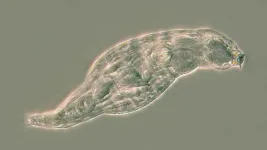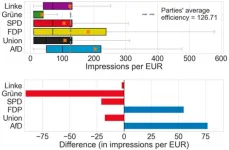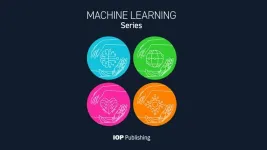(Press-News.org) CHICAGO — July 18, 2024 — The 65th Supplement to the American Ornithological Society’s (AOS’s) Check-list of North American Birds, published today in Ornithology, includes several updates to the classifications of bird species found in North America, Central America, and the Caribbean.
A few highlights from this year’s supplement, detailed below, include species splits for Troglodytes aedon (House Wren) and Tyto alba (Barn Owl); a lumping of Acanthis flammea (Common Redpoll), Acanthis hornemanni (Hoary Redpoll), and Acanthis cabaret (Lesser Redpoll); a genus merger for bitterns; and a genus split for plovers.
The Check-list, published since 1886, is updated in annual supplements from the AOS’s North American Classification Committee (NACC). The Check-list and its supplements provide the taxonomic and nomenclatural foundation for bird research, conservation, management, and education throughout the region, and are relied on as the authority on avian biodiversity by government agencies, NGOs, scientists, and birders, among others.
The taxonomic work of the NACC is distinct from the work of the AOS English Common Names Pilot Project, in which new common names will be determined for an initial set of six species of North American birds, part of an effort to change English names under the AOS’s purview that are harmful or exclusionary. A new ad hoc committee is being assembled to oversee this pilot project and to develop and test new procedures for guiding future changes to English bird names. This effort will include developing partnerships with multiple entities involved in selecting common names of birds throughout their geographic ranges, and designing a new process that engages the public in soliciting suggestions for suitable replacement English names. The NACC will continue to review proposals annually for taxonomic and distributional updates to the Check-list of North American Birds, and will be one of several groups working closely with the ad hoc English Common Names Pilot Project Committee on that new committee’s efforts.
The full 2024 Check-list supplement is available at: https://doi.org/10.1093/ornithology/ukae019.
Species Splits and Lumps
A “wrenaissance” in this year’s Check-list supplement
A successful proposal to “recognize multiple species within the House Wren Troglodytes aedon complex” (Proposal 2024-C-3a–l), submitted by Pamela C. Rasmussen, R. Terry Chesser, J. Van Remsen, Jr., and Brian Sullivan, is a boon for birders in the Caribbean. In a major shakeup of Troglodytes aedon (House Wren), what was formerly considered one species is now separated into seven species. A similar proposal considered in 2022 (Proposal 2022-B-10) failed to pass, but new data, including a near-comprehensive phylogeny based on mitochondrial DNA and genomic data, provided an opportunity to reevaluate the complex.
This new proposal’s authors again considered the status of the Caribbean forms beani, guadeloupensis, rufescens, martinicensis, mesoleucus, musicus, grenadensis, and albicans, but expanded their analysis to the continental forms parkmanii of western North America, brunneicollis of the Mexican highlands and southeastern Arizona, and the musculus group of eastern Mexico through South America, suggesting that “a broader geographic perspective is required, given the new data on phylogenetic relationships among continental forms.”
For this proposal, the NACC considered a variety of data, including genetics, song, morphology (plumage and measurements), ecology, behavior, and habitat. “The habitat, to me, was particularly persuasive for splitting island from mainland birds,” says R. Terry Chesser, of the U.S. Geological Survey and chair of the NACC. He explains, “Tropical mainland populations of House Wrens typically occur in villages and towns and thrive there, whereas the island populations, for the most part, occur in forests or other natural habitats. Chesser continues, “Many of the island birds are not doing well, because those habitats have been destroyed or disturbed extensively. If they were the same species, they would be thriving in the towns, urban areas, and villages like their mainland counterparts, but they’re not.” In addition, songs differ among the island populations, most remarkably so for T. musicus, the St. Vincent Wren, and played an important role in the decision to recognize additional species.
Why not treat all the island populations as a single species rather than splitting so many? “As it turns out, most island populations are not each other’s closest relatives, so they should not be considered the same species,” Chesser notes, adding, “There were clearly several independent colonizations of these islands.”
Elevation of Tyto furcata (American Barn Owl) to species status separate from Tyto alba
A proposal to break up the cosmopolitan Tyto alba (Barn Owl) complex (Proposal 2024-C-1), co-authored by Louis Bevier, Carla Cicero, Jon L. Dunn, Rosa Alicia Jiménez, and Oscar Johnson, used a combination of vocal and genetic data to propose separating the Barn Owl of the Americas, T. furcata (American Barn Owl), from those of the Old World. They specifically highlight “a distinctive and prominent flight call associated with mate attraction that is uttered by New World Barn Owls [furcata].” Significantly, this call, the “kleak-kleak” display call, does not occur in the Old World groups of Barn Owl (T. alba, Western Barn Owl; T. javanica, Eastern Barn Owl) and thus represents a diagnostic difference associated with breeding. The recognition of three species of barn owl is also concordant with the genetic data included in a 2018 proposal (that did not pass) on the same topic (Proposal 2018-C-13), which showed that these owls consist of three genetically separate lineages. “The acceptance of the new proposal,” Chesser says, “was due to its emphasis on vocalizations. The vocal differences, in combination with the genetics, indicate that the American Barn Owl is truly reproductively isolated from the other barn owls, and not just geographically isolated from them.”
Lumping of Acanthis hornemanni (Hoary Redpoll) and A. cabaret (Lesser Redpoll) with A. flammea (Common Redpoll)
These Holarctic passerines, named for their distinctive red forehead patch, were previously considered for lumping in a 2017 proposal (Proposal 2017-B-7). That proposal did not pass, due in part to a lack of genetic sampling from populations in Greenland and Iceland, as well as reports of assortative mating among the species. Now, Nicholas A. Mason, Erik Funk, and Scott A. Taylor have authored a new proposal (Proposal 2024-B-3) based on a study with whole-genome sequencing of A. cabaret, A. flammea, and A. hornemanni from across their ranges, including Greenland and Iceland. The sequencing shows that they are nearly identical genetically, except for an inversion in one of the chromosomes, despite variation in morphology, including bill size and shape, and plumage coloration. The authors write that “Funk et al. (2021) provide strong support that a chromosomal inversion—also known as a ‘supergene’—maintains phenotypic variation despite widespread gene flow between all currently named species.” Chesser explains, “A chromosomal inversion occurs when a part of the chromosome is detached and turned around, and then reinserted. This section of the chromosome is now backwards from what it used to be, and in these birds that inversion is responsible for the phenotypic differences we see in plumage and bill size and shape.” Significantly, presence or absence of the inversion does not affect interbreeding of the birds, and there is no evidence for long-term reproductive isolation. Moreover, an addendum to the proposal, authored by Chesser and Mason, summarized numerous studies purported to support assortative mating among redpolls, but which as a group provided rather weak evidence, especially when considered in light of the genomic data.
Genus Splits and Reallocations
A genus merger for the bitterns
Bitterns have been placed traditionally into two genera, Ixobrychus for the smaller bitterns and Botaurus for the larger species. However, new phylogenetic data reveal that some Ixobrychus species are more closely related to species of Botaurus than they are to other species of Ixobrychus. One of these species is North America’s Ixobrychus exilis (Least Bittern), which looks very similar to two other species that are vagrants to North America—Ixobrychus minutus (Little Bittern) and Ixobrychus sinensis (Yellow Bittern)— but is more closely related to the quite different Botaurus lentiginosus (American Bittern). Proposal 2024-A-2a–d, submitted to the committee by Chesser, proposed changes to the Checklist to better reflect evolutionary relationships among the bitterns. The NACC, taking note of the variation within Ixobrychus, decided to merge the two genera rather than transferring some but not all species of Ixobrychus to Botaurus. “In the end, we found it difficult to justify placing birds that were almost identical into two separate genera,” Chesser says, referring to I. exilis, I. sinensis, and I. minutus. “The two species of bittern in the U.S. differ dramatically, but if you take a global view, you find there’s quite a bit of variation in Ixobrychus,” Chesser explains. “The largest species of Ixobrychus approaches Botaurus in size, and some other species either have plumage that is intermediate between typical Ixobrychus and Botaurus or have female plumage very similar to that of Botaurus.” Therefore, all bitterns are now placed in the genus Botaurus.
A genus split for the plovers
Until now, plovers (Family Charadriidae) in the Americas had been placed into three genera: Vanellus for the lapwings, Pluvialis for the golden-plovers, and Charadrius for all other plovers. “Because the lapwings are so distinctive phenotypically, they had traditionally been treated as the separate subfamily Vanellinae,” Chesser explains. As it turns out, new genetic data highlighted in Proposal 2024-A-3a–h, submitted by Oscar Johnson, indicates that Pluvialis plovers are actually the most distinctive evolutionarily, having split off first from the others. Furthermore, the “species that we’ve traditionally placed in Charadrius don’t form a single evolutionary group by themselves,” says Chesser, “because the lapwings are part of that group and arose from within it.” As a result, the committee split Charadrius into two genera—Charadrius and Anarhynchus—to reflect their evolutionary relationships. Charadrius still includes such species as C. vociferus (Killdeer), C. semipalmatus (Semipalmated Plover), and C. melodus (Piping Plover). However, A. wilsonia (Wilson’s Plover), A. collaris (Collared Plover), and A. nivosus (Snowy Plover), among other species, are now placed in Anarhynchus and are actually more closely related to the lapwings than to species that look superficially similar but are retained in Charadrius. This new evolutionary information is also reflected in a revised linear sequence, in which Vanellus is now placed between Charadrius and Anarhynchus, and in the subfamily classification, which has eliminated subfamily Vanellinae but recognized the new subfamily Pluvialinae for golden-plovers.
About the journal
The journal Ornithology is a peer-reviewed, international journal of ornithology published by the American Ornithological Society (AOS). The journal’s name changed from The Auk to Ornithology in January of 2021. Ornithology commenced publication in 1884 under the banner of the American Ornithologists’ Union, the AOS’s predecessor society. In 2009, Ornithology was honored as one of the 100 most influential journals of biology and medicine over the past 100 years.
About the American Ornithological Society
The American Ornithological Society (AOS) is an international society dedicated to connecting ornithologists, science, and bird conservation by supporting science that advances the understanding and conservation of birds; promoting broad access to ornithological science; supporting ornithologists throughout their career paths; and fostering a welcoming, diverse, supportive, and dynamic ornithological community. The AOS publishes two top-ranked international scientific journals, Ornithology and Ornithological Applications, and hosts an annual conference that attracts ornithologists from across the globe. Its robust grants program supports student and early-career professional research initiatives. The society’s check-lists serve as the accepted authorities for scientific nomenclature and English common names of birds in the Americas. The AOS is also a partner with The Cornell Lab of Ornithology in the online Birds of the World, a rich database of species accounts of the world’s birds. The AOS is a 501(c)(3) nonprofit organization serving about 3,000 members globally. For more information, see www.americanornithology.org.
END
A “wrenaissance” for House Wrens; species and genus splits for Barn Owls and Plovers; and lumping of Redpolls included in 2024 Check-list changes
65th Supplement to the Check-list of North American Birds publishes today in Ornithology
2024-07-18
ELSE PRESS RELEASES FROM THIS DATE:
NFCR welcomes two new Board of Directors
2024-07-18
Rockville, MD – July 18, 2024
The National Foundation for Cancer Research (NFCR) announced new Board of Directors members today who both have been long-term supporters of the organization: Silas Deane, Vice President, Tyler Technologies, and Dr. Padmakumar Kaimal, previous Vice President of Technology Alliance & Business Development at Suven Life Sciences. The areas of expertise and leadership they bring to NFCR signify a pivotal moment for the organization working to advance the mission of providing new areas of hope and solutions for cancer patients worldwide.
Silas Deane has extended expertise in technology, healthcare, government relations, ...
In decade-first for Japan, Kyushu U Professor is elected as International Fellow of the British Academy
2024-07-18
Fukuoka, Japan — On 17 July 2024, the British Academy held its Annual General Meeting, where Koji Mizoguchi, Professor of Archaeology at Kyushu University's Faculty of Social and Cultural Studies, was elected as an International Fellow. He is the first Japanese archaeologist and the first researcher from Kyushu University to receive this honor.
Founded in 1902, the British Academy aims to deepen and share understanding of people, societies, and cultures across time and place, enabling ...
PEPITEM – a novel protective agent for inflammageing
2024-07-18
A naturally occurring peptide called PEPITEM could potentially rejuvenate the immune response in older individuals and protect against 'inflammageing', which is widely believed to be the root cause of many age-related diseases.
The study, published today in the journal npj Aging, raises the exciting possibility of a protective agent that could dampen age-related inflammation and restore normal immune function in older adults.
PEPITEM (Peptide Inhibitor of Trans-Endothelial Migration) was initially identified at the University ...
Small animals acquire genes from bacteria that can produce antibiotics
2024-07-18
WOODS HOLE, Mass. -- A group of small, freshwater animals protect themselves from infections using antibiotic recipes “stolen” from bacteria, according to new research by a team from the University of Oxford, the University of Stirling and the Marine Biological Laboratory (MBL), Woods Hole.
The tiny creatures are called bdelloid rotifers, which means ‘crawling wheel-animals’. They have a head, mouth, gut, muscles and nerves like other animals, though they are smaller than a hair’s breadth.
When these rotifers are exposed to fungal infection, the study found, ...
Unexpected role of OTX2 drives aggressive medulloblastoma
2024-07-18
In a report published in Nature Cell Biology, researchers at Baylor College of Medicine, Texas Children’s Hospital, the University of Manitoba and collaborating institutions revealed an unexpected way in which the protein OTX2 drives the progression of medulloblastoma – the most common aggressive childhood brain cancer. The findings suggest that targeting OTX2 or its effects can have therapeutic relevance.
“We see medulloblastoma stem cells as the root of the disease. The tumors develop from these cells early during development of the cerebellum, the brain region ...
Study shows new efficiency standards for heavy trucks could boost energy use
2024-07-18
Deliveries are getting faster than ever in the U.S., but the faster movement of goods is undercutting the country’s climate progress.
In a new study published July 18 in the journal Nature Energy, a CU Boulder researcher and his collaborator estimate that federal regulations aimed at enhancing heavy-duty trucks’ energy efficiency could be as much as 20% less effective than policymakers initially anticipated.
That’s because the regulations make trucking cheaper. As a result, more shippers will likely switch from using less energy-intensive rail transportation to using more energy-intensive trucks to ship goods.
“We ...
Minerals play newly discovered role in Earth’s phosphorus cycle
2024-07-18
Northwestern University-led researchers have discovered a new way that nature cycles phosphorus, a finding that uncovers a missing piece of Earth’s puzzling phosphorus cycle.
The research will be published on Thursday (July 18) in the journal Nature Communications.
A critical nutrient for plant growth, phosphorus is a non-negotiable component of fertilizers. Without it, farmers cannot ensure plant health and boost crop yields. Understanding Earth’s phosphorus cycle, therefore, is important for protecting the global food supply.
Although ...
Social media: How algorithms influence election campaigns
2024-07-18
Milano, 18 luglio 2024 – A new study published in the journal PNAS Nexus reveals how social media algorithms favor politically sponsored content from certain parties given the same investment budget.
The research, a collaboration between the Politecnico di Milano, LMU – Ludwig Maximilians Universität of Munich, and the CENTAI institute of Turin, analyzed over 80,000 political ads on Facebook and Instagram before the 2021 German federal elections. These ads were placed by parties across the political spectrum and generated over 1.1 billion impressions during an election with more than 60 million eligible voters.
Investigating ...
IOP Publishing launches series of open access journals dedicated to machine learning and artificial intelligence for the sciences
2024-07-18
IOP Publishing (IOPP) is launching the world’s first series of open access journals dedicated to the application and development of machine learning (ML) and artificial intelligence (AI) for the sciences. The new multidisciplinary Machine Learning series will collectively cover applications of ML and AI across the physical sciences, engineering, biomedicine and health, and environmental and earth science.
Building on the successful launch of Machine Learning: Science and Technology in 2019, IOPP’s Machine Learning series will expand to include three new ...
Research shows young infants use their mother’s scent to see faces
2024-07-18
Humans see the world through the five senses, but how and when the ability to integrate across the senses arises is debated. Research shows that humans combine sensory information together, particularly when one sense is not able to produce a sufficient response alone. Studies also show that infants may use multisensory cues to perceive their environments more efficiently. A new Child Development study by researchers at the Université de Bourgogne, University of Hamburg, Université de Lyon, Institut Universitaire de France, Université de Lorraine, Centre Hospitalier de Nancy, and Centre National de la Recherche Scientifique ...
LAST 30 PRESS RELEASES:
Exposure to natural light improves metabolic health
As we age, immune cells protect the spinal cord
New expert guidance urges caution before surgery for patients with treatment-resistant constipation
Solar hydrogen can now be produced efficiently without the scarce metal platinum
Sleeping in on weekends may help boost teens’ mental health
Study: Teens use cellphones for an hour a day at school
After more than two years of war, Palestinian children are hungry, denied education and “like the living dead”
The untold story of life with Prader-Willi syndrome - according to the siblings who live it
How the parasite that ‘gave up sex’ found more hosts – and why its victory won’t last
When is it time to jump? The boiling frog problem of AI use in physics education
Twitter data reveals partisan divide in understanding why pollen season's getting worse
AI is quick but risky for updating old software
Revolutionizing biosecurity: new multi-omics framework to transform invasive species management
From ancient herb to modern medicine: new review unveils the multi-targeted healing potential of Borago officinalis
Building a global scientific community: Biological Diversity Journal announces dual recruitment of Editorial Board and Youth Editorial Board members
Microbes that break down antibiotics help protect ecosystems under drug pollution
Smart biochar that remembers pollutants offers a new way to clean water and recycle biomass
Rice genes matter more than domestication in shaping plant microbiomes
Ticking time bomb: Some farmers report as many as 70 tick encounters over a 6-month period
Turning garden and crop waste into plastics
Scientists discover ‘platypus galaxies’ in the early universe
Seeing thyroid cancer in a new light: when AI meets label-free imaging in the operating room
Neutrophil-to-lymphocyte ratio may aid risk stratification in depressive disorder
2026 Seismological Society of America Annual Meeting
AI-powered ECG analysis offers promising path for early detection of chronic obstructive pulmonary disease, says Mount Sinai researchers
GIMM uncovers flaws in lab-grown heart cells and paves the way for improved treatments
Cracking the evolutionary code of sleep
Medications could help the aging brain cope with surgery, memory impairment
Back pain linked to worse sleep years later in men over 65, according to study
CDC urges ‘shared decision-making’ on some childhood vaccines; many unclear about what that means
[Press-News.org] A “wrenaissance” for House Wrens; species and genus splits for Barn Owls and Plovers; and lumping of Redpolls included in 2024 Check-list changes65th Supplement to the Check-list of North American Birds publishes today in Ornithology




